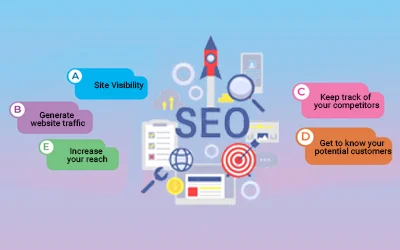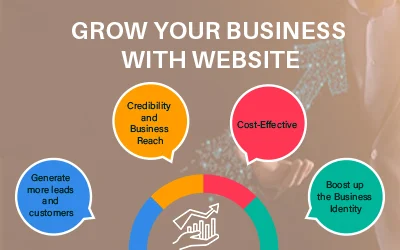Creating an effective website that attracts and engages your target audiences involves careful planning and execution across multiple phases. While each website project may differ in exact scope, the core stages remain similar. Understanding this website development process helps set realistic expectations and ensures success.
This blog will give an in-depth overview of the web development process across seven key stages. But before that, let's understand what is web development process.
What Is The Web Development Process?
The process of web development is creating and maintaining websites or web applications. It involves some steps that start with planning and conceptualizing the project.
The next step involves designing the user interface and determining the general structure and format. Once the layout is complete, developers move on to the actual coding, where they write the basic HTML, CSS, and JavaScript code to bring the design to life.
Testing is an important step to identify and plug any bugs or problems, which ensures that websites or tools work easily through exclusive devices and browsers. The final step is to make the website live and practical for the user. Ongoing maintenance and updates are also part of the website development process steps to keep the site or application latest and secure.
Now, let's understand these steps of web development process in detail:
Stage 1: Information Gathering – Defining Project Scope
Defining the purpose and parameters of your planned website at the start will take all the after activities in the right direction. This web development process involves research on the target audience, competitors, goals, and content structure through methods like surveys, interviews, and focus groups.
Key aspects to cover:
- Purpose – What goals do you want the website to achieve? Lead generation? Sales? Brand awareness? Define specific metrics for tracking.
- Audience Personas – Gather demographics like age, location, and pain points of main visitor groups. Map groups to your offerings.
- Competitor Benchmarking – Analyze current player website designs, features, traffic acquisition strategies, and more to identify gaps and ideas.
- Site Map – Structure required web pages hierarchically around areas like home, products, services, about us, contact us, etc.
- Technology Choices – Explore platform options like content management systems (CMS), e-commerce capabilities, plugins, etc., within budget.
When creating a website, it's important to document the goals, audience expectations, competitive advantages, and technology options. These website development process steps help with planning and measuring success after the launch.
Stage 2: Planning – Aligning Structure to Goals
Having established direction, the next activity in website development steps involves conceptualizing site information architecture (IA) and wireframes. IA focuses on organizing content and navigation so visitors can intuitively find information. Wireframes visualize page layouts and core elements in the website designing process without visual design.
Key aspects of this website development process include:
- IA Design – Group content into logical sections and sub-sections tailored to serving identified user goals
- Navigation Menu – Define entries and drill-down sub-menu levels
- Page Wireframes – Map section content into storyboard page outlines depicting core fields
- User Journeys – Define key user workflows end-to-end spanning clicks to achieve outcomes
- Development Plan – Breakdown effort into release cycles by priorities if adopting agile methodology
Having sound IA blueprints and mockups ensures alignment on the proposed solution structure and usability before the time-consuming visual design and development stages. User walkthroughs provide feedback to refine information findability and paths to fulfill tasks.
Stage 3: Design - Formulating Visual Appeal
This creative process of web development transforms wireframes into visually appealing designs incorporating brand elements like logos, colors, imagery, and themes. The style guide and asset library set the tone and emotions a website needs to evoke. Page templates maintain consistency across sections. Compelling, original content and visuals raise findability through emotional connections raising viral potential.
Key aspects:
- Style Guide – Compiles guidelines around typography, color schemes, image treatments, etc.
- Page Templates – Common headers, footers, sidebars
- Graphic Assets – Images, illustrations, icons
- Content Tone – Catchy taglines, headlines, captions
The goal is visually appealing designs that align with brand identity and audience preferences for maximum engagement upon launch. An immersive experience holds visitor attention, encouraging actions like downloads, transactions, etc., functioning as additional evaluation criteria.
Stage 4: Content Creation – Adding Value Through Copy
Every website development process relies extensively on writing distributed across sections like homepage introductions, product descriptions, blogs, etc. Meeting high-quality benchmarks raises brand perception and SEO through reviews and shares. Balance copy complexity based on target reader levels.
Key aspects:
- Blogs/Articles – Engaging industry topics attract shares
- Website Copy – Page introductions, product/ service details
- Calls-to-Action – Gated offers encouraging downloads, subscriptions
- Accessibility – Legal standards compliance for visually challenged
- SEO Optimization – Keyword integration
Well-crafted, useful content has a compounding effect on brand awareness and inbound inquiries over time.
Stage 5: Development and Coding – Bringing the Blueprint to Life
The development and coding steps of web development process are when the website design gets converted into actual web pages that visitors can access. The developers take the approved designs and start writing lines of code that browsers can interpret to render text, images, links, and other elements on the user's screen. Coding involves web languages like:
- HTML - Defines content structure
- CSS - Controls layout styles and formatting
- JavaScript - Adds interactivity and complex functions The developers digitally recreate the website design page-by-page in the above codes.
Key website development steps in the coding phase include:
- Coding the homepage first as the core starting point
- Adding other key pages mapped during site mapping
- Building site templates for common components like headers, footers, menus
- Integrating features like forms, and search bars using code
- Connecting to databases that store and serve website data
- Ensuring site responsiveness on mobiles, tablets, and desktops
- Continuously testing and fixing coding errors as they appear
Choosing the right coding tools and popular web development frameworks accelerates the overall build process. Complex sites with custom features take more time to code based on scope.
Stage 6: Testing, Review, Launch– Ensuring Real-world Usability
Each website development process should budget at least three weeks pre-launch for rigorous multi-parameter testing to identify outstanding defects or issues prior to public unveiling. Skipping checks risks reputation and viral visitor drops after issues surface post-launch.
Key test buckets for this web development process:
- Site Speed – Pages redirects load under 3 seconds during peak load testing
- Link Errors – No broken links or images using crawler tools
- Responsiveness – Style continuity across devices
- Browser Compatibility – Verify on Chrome, Firefox, Safari
- Security – Address vulnerabilities spotted on running exploit tests
Define test cases mapped to every requirement during signing-off launch readiness. Zero critical defects release baseline allows launch.
Stage 7: Maintenance – Sustaining Performance
Websites need ongoing upgrades, content improvements, and technical robustness long after public unveiling through:
Key aspects:
- Monitoring user metrics – traffic volumes, visit duration, bounce rates
- Regular content publishing for freshness and SEO
- Releasing functionality enhancements based on user feedback
- Evaluating new technologies to refresh site appeal
- Proactive security patching for core website frameworks
Maintenance in the web development process focuses on marketing, technology, and content to keep sites engaging. Think of website launch in website development steps as the starting point rather than the final outcome.
Read our other blog for the ultimate guide on the Website designing process
The Bottom Line
Building a successful and high-performing website involves a multi-disciplinary, multi-phase effort spanning research, planning, design, development, testing, and post-launch activities. In summary, excelling at the website development process steps requires a multitude of capabilities spanning project management, research, design, content, coding, analytics, and digital marketing. For basic websites, you can use online DIY builders. However, if your website is an enterprise-level web application, it is best to seek the help of a professional Web Development Company. InvoIdea can provide skilled professionals with the expertise to assist in creating a website for businesses from start to finish. This end-to-end assistance ensures that you get the help you need to succeed.











